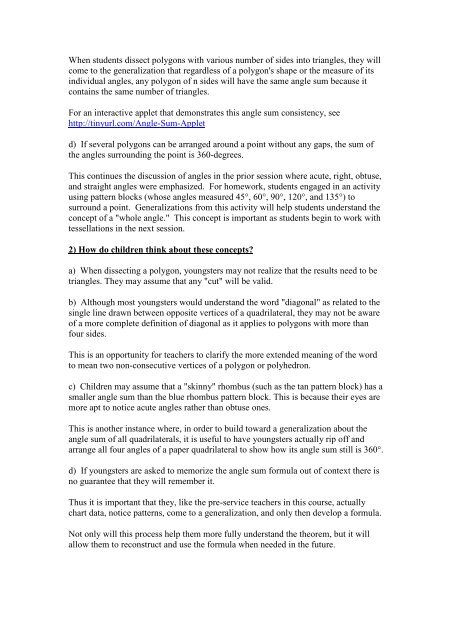Course Guide - USAID Teacher Education Project
Course Guide - USAID Teacher Education Project
Course Guide - USAID Teacher Education Project
Create successful ePaper yourself
Turn your PDF publications into a flip-book with our unique Google optimized e-Paper software.
When students dissect polygons with various number of sides into triangles, they willcome to the generalization that regardless of a polygon's shape or the measure of itsindividual angles, any polygon of n sides will have the same angle sum because itcontains the same number of triangles.For an interactive applet that demonstrates this angle sum consistency, seehttp://tinyurl.com/Angle-Sum-Appletd) If several polygons can be arranged around a point without any gaps, the sum ofthe angles surrounding the point is 360-degrees.This continues the discussion of angles in the prior session where acute, right, obtuse,and straight angles were emphasized. For homework, students engaged in an activityusing pattern blocks (whose angles measured 45°, 60°, 90°, 120°, and 135°) tosurround a point. Generalizations from this activity will help students understand theconcept of a "whole angle." This concept is important as students begin to work withtessellations in the next session.2) How do children think about these concepts?a) When dissecting a polygon, youngsters may not realize that the results need to betriangles. They may assume that any "cut" will be valid.b) Although most youngsters would understand the word "diagonal" as related to thesingle line drawn between opposite vertices of a quadrilateral, they may not be awareof a more complete definition of diagonal as it applies to polygons with more thanfour sides.This is an opportunity for teachers to clarify the more extended meaning of the wordto mean two non-consecutive vertices of a polygon or polyhedron.c) Children may assume that a "skinny" rhombus (such as the tan pattern block) has asmaller angle sum than the blue rhombus pattern block. This is because their eyes aremore apt to notice acute angles rather than obtuse ones.This is another instance where, in order to build toward a generalization about theangle sum of all quadrilaterals, it is useful to have youngsters actually rip off andarrange all four angles of a paper quadrilateral to show how its angle sum still is 360°.d) If youngsters are asked to memorize the angle sum formula out of context there isno guarantee that they will remember it.Thus it is important that they, like the pre-service teachers in this course, actuallychart data, notice patterns, come to a generalization, and only then develop a formula.Not only will this process help them more fully understand the theorem, but it willallow them to reconstruct and use the formula when needed in the future.
















